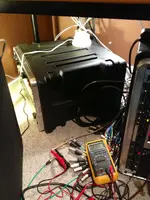Yeah, I don't care for a museum piece, but I'd be a fool not to live with and get accustomed to the machine stock before modifying stuff. Eventually the 'lytics will be replaced with equivalent low ESR modern parts, adjusting values where advised (which includes an increase in the voltage rating of C32 on the Record PWA, increase in capacitance of the output coupling cap which is probably the BEST bang-for-the-buck improvement, and slight increase in the local supply filter...). I WON'T be replacing the multi-section electrolytic caps unless there is a functional problem because those deal with timing delays...they don't handle audio. Also bypassing the 5uF cap on the octal socket as I won't be using the plug in mic transformers there. And I think upgrading of the electronics power supplies is key which I have done for the first two supplies; I used Mallory computer grade caps for the main and secondary filters (with an upgrade in voltage and capacitance on the main filter cap), and replaced the rectifiers with new 1N4008 parts...also replaced the bleed resistor and bypassed the main filter cap with a small value cap. Outside of that I likely won't be doing much more secondary to the curve of diminishing returns compared to cost. There are people that insist on replacing all the electrolytics on the PWAs with huge expensive film caps, and bypassing the transformers, etc. I know that's not what you are going for necessarily, but my anchor is something that Steve Puntolillo said to me a couple years ago..."Replace that output coupling cap and the local filter, change out the electrolytics on the amp cards, and set it up at 15ips NAB and it'll sound like an Ampex." That's what I want. Then if I decide its NOT what I want after living with it awhile as is, I can tinker or go a completely different route, but at some point its lipstick on a pig (not that the MM-1000 is a pig by any means...the "pig" represents *anything* that is in discord with what you want or need). You can change all the tants and film caps out for higher quality films, bypass all the larger value lytics...replace all the carbon comp resistors with metal film, blahblahblah...but I've heard some GREAT recordings come off of stock MM-1000s. And the fact that the amplifier circuit is little changed from the AG-440 all the way through the MM-1200. I mean, there are plenty of folks that don't and/or didn't consider the MM-1200 as the go-to machine, but they weren't after what it offered and still does...the MM-1200 was definitely and remains a top choice, and it was one of the kings in an age when everything was going to IC opamps and transformerless topology to pursue "transparency", and yet the MM-1200 is all transformer coupled and discrete class A circuitry. Antiquated, right. Bleh. If I want transparent I can use my digital rig.





